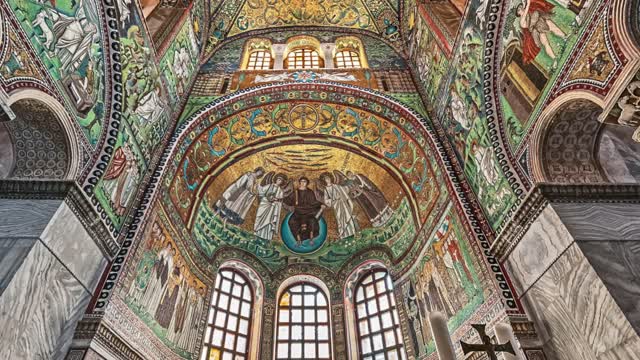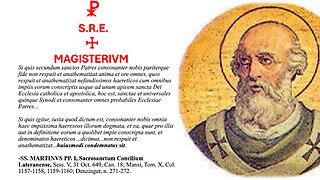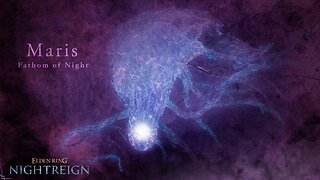Premium Only Content

Salve Festa Dies Per Templum S. Vitalis Ravennae
Salve Festa Dies Per Templum S. Vitalis Ravennae
http://zazzle.com/ProVaticanus
1. Salve festa dies toto venerabilis aevo
Qua Deus infernum vicit et astra tenet
2. Ecce renascentis testatur gratia mundi
Omnia cum Domino dona redisse suo
3. Namque triumphanti post tristia tartara Christo
Undique fronde nemus gramina flore favent
4. Qui crucifixus erat Deus, ecce per omnia regnat
Dantque Creatori cuncta creata precem
5. Christe, salus rerum, bone Conditor atque Redemptor
Unica progenies ex Deitate Patris
6. Qui genus humanum cernens mersisse profundo
Ut hominem eriperes es quoque factus homo
7. Funeris exsequias pateris vitae auctor et orbis
Intras mortis iter dando salutis opem
1. Hail, festal day, venerable of all ages
By which God conquers hell and holds the stars
2. Behold, it declares grace for a reborn world
All gifts have returned with their Lord.
3. For indeed, after hellish sorrows, to the triumphing Christ:
grove with green and buds with flower, everywhere give laud.
4. The Crucified One was God, behold He reigns over all things,
and all creation offers prayer to its Creator.
5. O Christ, the salvation of all things,
good Creator and Redeemer, only begotten Son of God the Father.
6. You Who, seeing mankind to have plunged to the deep,
that you might save man, were also made man.
7. That Thou, the author of life and the world, might open
the way of death and the grave by giving hope of salvation.
This is one of the oldest hymns used by the Church, written by Venantius Fortunatus before 609 AD! Sublime, poetic, and beautiful, this hymn is considered extremely precious by the Church. She only makes use of it once a year, during the greatest feast of her liturgical year! Easter is indeed the greatest feast, even greater than Christmas. There is at least 40 days preparation for Easter, but only 4 weeks for Christmas. Furthermore, Our Lord was born in order to redeem us -- so the feast celebrating his life's mission (the Redemption) must be the most important. This sequence is often sung before the Day Mass of Easter Sunday.
Basilica San Vitale (526-547 AD) - Ravenna, Italy. Splendid Mosaics in the only large intact Church of the time of Roman Emperor Justinian the Great. The main building of the church is laid out octagonally. The building combines Roman and Byzantine elements. The dome, shape of doorways, and stepped towers are typical of Roman style, while the polygonal apse, capitals, narrow bricks, and an early example of flying buttresses are typical of the Byzantine. The church is most famous for its wealth of Byzantine mosaics. St Vitale boasts the largest and best preserved mosaics outside of Istanbul. The church is of extreme importance in Byzantine art, as it is the only major church from the period of the Emperor Justinian I to survive virtually intact. Furthermore, it is thought to reflect the design of the Byzantine Imperial Palace Audience Chamber, of which nothing at all survives. The belltower has four bells. According to legends, the church was erected on the site of the martyrdom of Saint Vitalis. However, there is some confusion as to whether this is the Saint Vitalis of Milan, or the Saint Vitale whose body was discovered (together with that of Saint Agricola) by Saint Ambrose in Bologna in 393.
At the foot of the apse side walls are two famous mosaic panels, completed in 547. On the right is a mosaic depicting Justinian I, clad in Tyrian purple with a golden halo, standing next to court officials, generals Belisarius and Narses, Bishop Maximian, palatinae guards and deacons. The halo around his head gives him the same aspect as Christ in the dome of the apse, but is part of the tradition of rendering the imperial family with haloes described by Ernst Kantorowicz in The King's Two Bodies. Justinian himself stands in the middle, with soldiers on his right and clergy on his left, emphasizing that Justinian is the leader of both church and state of his empire. The later insertion of the Bishop Maximian's name above his head suggests that the mosaic may have been modified in 547, replacing the representation of the prior bishop with that of Maximian's.
The gold background of the mosaic shows that Justinian and his entourage are inside the church. The figures are placed in a V shape; Justinian is placed in the front and in the middle to show his importance with Bishop Maximian on his left and lesser individuals being placed behind them.
Another panel shows Empress Theodora solemn and formal, with golden halo, crown and jewels, and a group of court women as well as eunuchs. The Empress holds the Eucharistic vessel for wine, and her panel differs from that of Justinian in having a more complex background, with a fountain, cupola, and lavish hangings.
Ago tibi gratias Deo per instrumenta de archive.org pro bono rei publicae: https://archive.org/details/PaschaGregorianChant/Easter+-+Hymn+-+Salve+Festa+Dies.MP3
#SalveFestaDies #Ravenna #GregorianChant
-
 2:06
2:06
ProVaticanus
2 months agoMAGISTERIVM SS. MARTINI PP. I CONTRA INDIFFERENTISTAS #SRE #Pontifex #Magisterium #Canon
66 -
 LIVE
LIVE
DamnDanieI
4 hours agoKill First, Loot Later – OTG Live
331 watching -
 56:41
56:41
Donald Trump Jr.
8 hours agoLies, Leaks, and Lawfare: Censorship Corruption Exposed | TRIGGERED Ep.263
140K120 -
 1:19:46
1:19:46
Precision Rifle Network
5 hours agoS4E25 Guns & Grub - Rex Is Back, I shot the 6.5PRC finally...
11.6K1 -
 LIVE
LIVE
rhywyn
3 hours agoうつ
28 watching -
 LIVE
LIVE
RyuMuramasa✧
4 hours agoNEW Everdark Sovereign | Elden Ring Nightreign | LIVE Playthrough
41 watching -
 1:17:04
1:17:04
Nikko Ortiz
12 hours agoLive - News, Politics, Podcast And Naaah Im Playin We Chillen
5.58K -
 1:26:13
1:26:13
Mally_Mouse
7 hours agoLet's Hang!! -- P.O. Box & Chill!
18.7K -
 1:02:37
1:02:37
BonginoReport
7 hours agoKamala Teases Book About Dumpster Fire Campaign - Nightly Scroll w/ Hayley Caronia (Ep.102)
72.6K58 -
 35:05
35:05
Stephen Gardner
7 hours ago🔥Obama will be FORCED to Testify in Trump trial?
33.6K54